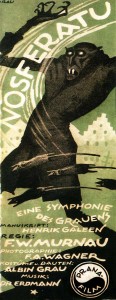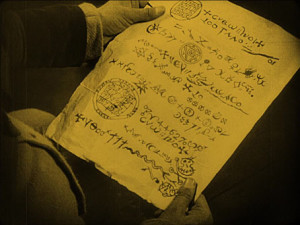 The May 2015 issue of Fortean Times caught my eye when I was in the bookstore on Friday. On the cover was Max Shrek made up as Count Orlok in the silent horror film classic Nosferatu as the illustration for a story by Brian Robb titled “Nosferatu: The Vampire and the Occultist.” As a scholar of religion, the Western esoteric tradition is an area of interest for research, and when this comes together with horror then it becomes the best of both worlds in religion and pop culture studies.
The May 2015 issue of Fortean Times caught my eye when I was in the bookstore on Friday. On the cover was Max Shrek made up as Count Orlok in the silent horror film classic Nosferatu as the illustration for a story by Brian Robb titled “Nosferatu: The Vampire and the Occultist.” As a scholar of religion, the Western esoteric tradition is an area of interest for research, and when this comes together with horror then it becomes the best of both worlds in religion and pop culture studies.
Robb’s article tells the story of Albin Grau and his Prana-Film. Grau us credited with costume design for Nosferatu, but he was responsible for far more in this film. Much of his pre-production artwork found its way into promotional posters for the film (including the one in the image accompanying this post) and it also influenced the visual and conceptual elements of the rat and infection that shaped the look of Count Orlok. In addition, Prana-Film was Grau’s production company. “Prana” coming from Hinduism and the Western esoteric tradition of religion and it refers to the life force or vital energy.
Grau was a practitioner of the occult that experienced a revival during the Weimar Republic in Germany, an interest fueled by the nation’s defeat in World War I and the further devastation from the 1918 Spanish Flu. Robb describes Grau’s esoteric involvement:
“Albin Grau’s occult interests were far-reaching, but his main affiliation was to Fraternitas-Saturni, the ‘Brotherhood of Saturn’, a German mystical order founded in the late 1920s. Prior to that, Grau had many titles and many roles – if there was a [sic] occult group active in the early 20th century then he was probably a member. Under the alias ‘Frater Pacitus’, he was a Master of the Pansophical Lodge, where he first met fellow occultist Eugene Grosche. Gray was also briefly an initiatve of the Ordo Templi Orientis, or OTI, primarily associated with the ‘great beast’ himself, Aleister Crowley.”
Robb cites the work of Raymond Owen in an online essay titled “Nosferatu and the Occult(ists)” that expands on the occult connections of Grau:
“Grau’s occultist affiliations are of considerable interest, eventually reaching even to Aleister Crowley, although that connection was tenuous in his filmmaking years. Grau was a practitioner of mystery rituals and a close associate of Heinrich Tränker, a seller of esoteric books who founded several ‘pansophic’ groups in Weimar Germany. Tränker’s ‘Pansophia’ (‘all-wisdom’) was a program of occultist syncretism based on the close study of arcane traditions: alchemy, freemasonry, theosophy, ritual magick, rosicrucianism, astrology, templarism, ‘the hidden knowledge of the East’ etc. Sometime in the early ’20s—right about the time his friend and fellow occultist Grau was launching Prana-Film and preparing to make Nosferatu—Tränker consolidated his various groups into the Grand Pansophical Lodge of the Orient—Berlin, with himself as Grand Master. Grau served under him in an office called ‘Master of the Chair.’”
 According to Robb, Grau not only included elements of esotericism in Nosferatu, but he also embedded various esoteric messages in the film. Robb did not demonstrate the latter claim to my satisfaction, but he does draw attention to a scene in the film where a contract between Orlock and the character Hutter is shown. The document only shows on screen for a few seconds, but it does include occultic symbolism.
According to Robb, Grau not only included elements of esotericism in Nosferatu, but he also embedded various esoteric messages in the film. Robb did not demonstrate the latter claim to my satisfaction, but he does draw attention to a scene in the film where a contract between Orlock and the character Hutter is shown. The document only shows on screen for a few seconds, but it does include occultic symbolism.
Robb discusses the symbols and says they “are largely astrological in nature, evoking the Moon (Luna), Mars, and Saturn, as well as Satan himself. The intention was to suggest the contract with Count Orlok is actually a pact with the Devil, suggested through the use of personal sigils.” Robb goes on to say that “some magical practitioners” consider the symbols on the contract authentic, but “if translated stricly according to tradition, produce something akin to gobbledegook.” Unfortunately, Robb fails to provide a citation or bibliographical references for this.
This is the first time I’ve heard of any connection between esotericism and Nosferatu. It sounds like it might be worth pursuing with further research.
Related post:





One Response to “The Esoteric “Nosferatu””